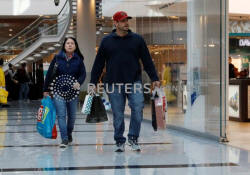U.S. retail sales, labor market data paint upbeat
economic picture
 Send a link to a friend
Send a link to a friend
 [April 19, 2019]
By Lucia Mutikani [April 19, 2019]
By Lucia Mutikani
WASHINGTON (Reuters) - U.S. retail sales increased by the
most in 1-1/2 years in March as households boosted purchases of motor
vehicles and a range of other goods, the latest indication that economic
growth picked up in the first quarter after a false start.
The economy's enduring strength was reinforced by other data on Thursday
showing the number of Americans filing applications for unemployment
benefits dropped to the lowest in nearly 50 years last week. Fears of an
abrupt slowdown in growth escalated at the turn of the year after a
batch of weak economic reports.
They were also exacerbated by a brief inversion of the U.S. Treasury
yield curve in late March. But those concerns have dissipated in recent
weeks amid fairly upbeat data on trade, inventories and construction
spending that have suggested growth last quarter could be better than
the moderate pace logged in the final three months of 2018.

A report from the Federal Reserve on Wednesday described economic
activity as expanding at a "slight-to-moderate" pace in March and early
April. The Fed's "Beige Book" report of anecdotal information on
business activity collected from contacts nationwide showed a "few" of
the U.S. central bank's districts reported "some strengthening."
"The rebound in retail sales underscores that the domestic outlook
remains favorable and well-supported by the labor market, and it dispels
the misguided concerns that the U.S. economy is slipping into
recession," said Kathy Bostjancic, head of U.S. macro investor services
at Oxford Economics in New York.
The Commerce Department said retail sales surged 1.6 percent in March,
the biggest increase since September 2017, after dropping 0.2 percent in
February. Economists polled by Reuters had forecast retail sales
accelerating 0.9 percent last month.
With March's rebound, retail sales have now erased the plunge in
December that put consumer spending and the overall economy on a sharply
lower growth trajectory. Retail sales last month were probably lifted by
tax refunds, even though they have been smaller than in previous years,
following the revamping of the U.S. tax code in January 2018.
Excluding automobiles, gasoline, building materials and food services,
retail sales rebounded 1.0 percent in March after declining 0.3 percent
in February. These so-called core retail sales correspond most closely
with the consumer spending component of gross domestic product.

Consumer spending accounts for more than two-thirds of economic activity
and is being buoyed by a tightening labor market that is driving up wage
growth.
STRONG LABOR MARKET
A separate report from the Labor Department on Thursday showed initial
claims for state unemployment benefits dropped 5,000 to a seasonally
adjusted 192,000 for the week ended April 13, the lowest level since
September 1969. Claims have now declined for five straight weeks.
Economists had forecast claims rising to 205,000 in the latest week.
[to top of second column] |

People walk with shopping bags at Roosevelt Field mall in Garden
City, New York, U.S., December 7, 2018. REUTERS/Shannon Stapleton

Though the trend in hiring has slowed, job gains remain above the roughly
100,000 needed per month to keep up with growth in the working-age population.
The reports boosted the dollar against a basket of currencies. Stocks on Wall
Street were mixed, while U.S. Treasury prices rose.
As a result of March's strong core retail sales, the Atlanta Fed raised its
first-quarter GDP estimate by four-tenths of a percentage point to a 2.8 percent
annualized rate.
Growth forecasts for the January-March quarter have been upgraded from as low as
a 0.5 percent rate following the recent trade, inventories and construction
spending data. The economy grew at a 2.2 percent pace in the fourth quarter.
Stronger growth in the first quarter will probably not change the view that the
economy will slow this year as the stimulus from a $1.5 trillion tax cut package
diminishes and the impact of interest rate hikes over the last few years
lingers.
It also is unlikely to have any impact on monetary policy after the Fed recently
suspended its three-year campaign to tighten monetary policy. The central bank
dropped projections for any rate hikes this year after increasing borrowing
costs four times in 2018.

"Key downside risks to U.S. growth are fading from view," said Allison Nathan,
an economist at Goldman Sachs in New York. "While we still think the next Fed
move is much more likely to be a hike than a cut, we've pushed back our forecast
for the next hike from the first quarter to the fourth of next year."
Goldman Sachs has lifted its growth estimate for the second half of 2019 by 25
basis points to 2.5 percent. Despite the recent wave of relatively strong data,
business surveys suggest pockets of weakness persist, especially in
manufacturing.
A third report on Thursday from the Philadelphia Fed showed factory activity in
the mid-Atlantic region slowed in April and manufacturers were less optimistic
about business and labor market conditions over the next six months.
That was corroborated by a fourth report from data firm IHS Markit showing its
measure of national factory activity was unchanged near a two-year low in early
April, with the survey's gauge of factory employment dropping to its lowest
level since June 2017.
"Many of the 'hard' readings on activity suggest that the economy started
picking up momentum late in the first quarter, but this is not evident in much
of the recent survey data," said Daniel Silver, an economist at JPMorgan in New
York.
(Reporting by Lucia Mutikani; Editing by Paul Simao)
[© 2019 Thomson Reuters. All rights
reserved.] Copyright 2019 Reuters. All rights reserved. This material may not be published,
broadcast, rewritten or redistributed.
Thompson Reuters is solely responsible for this content. |